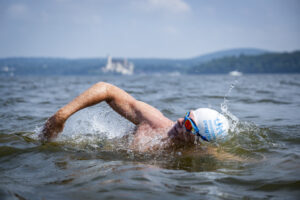
When Lewis Pugh reached the stretch of the Hudson River that runs along the Westchester County shoreline, the end of his 315-mile swim down the river’s entire length was in sight — literally.
On Sept. 9 — Day 28 of a 32-day swim — a tired but determined Pugh crossed the river from Bowline Point Park in Haverstraw to Sleepy Hollow Manor, a 7.6-mile effort. The following day, he swam 6.9 miles to Dobbs Ferry, where he could finally glimpse the Manhattan skyline.
The 53-year-old British-born endurance swimmer made sure he was in sync with the Hudson’s outgoing tides, which were at their most powerful from noon to 2 p.m. and midnight to 2 a.m. during those two days.
“The tides at that time were very strong at night, much stronger than during the day, and so because I was tired, we tried to focus on the nighttime section to get as much of the swimming done as possible,” Pugh said during a recent video chat from Plymouth, U.K.
He had little time to rest because of media requests pouring in as he neared his goal of becoming the first person to swim the entire Hudson unassisted, meaning he wore only a Speedo, cap, and goggles, without the benefit of a wetsuit.

Pugh was also busy finishing the speech he would deliver at the United Nations’ General Assembly on Sept. 14.
He stopped off in Croton-on-Hudson on Sept. 9 to express gratitude for the decision by state lawmakers to block discharge of radioactive water into the river as part of the Indian Point nuclear plant’s decommissioning.
“Oceans and rivers should never become dumping grounds, and so obviously I was relieved,” he said.
An “exhausted but rejuvenated” Pugh reached Battery Park on Sept. 13, after a journey that started at Lake Tear of the Clouds in the Adirondacks on Aug. 13.
Primarily relying on a powerful crawl stroke, Pugh switched periodically to the backstroke to give his back muscles a rest and open up the chest and pectoral muscles.
Pugh, who serves as the United Nations’ patron of rivers, undertook the journey to highlight the importance of river health to the health of the world’s oceans and the global environment. His previous efforts have traversed the English Channel, Red Sea and Antarctica’s Ross Sea.
Hudson’s ‘Incredible Story’

During the trip’s early stages, Pugh had to run along the shoreline when the river was too shallow to swim, and then had to dodge rocks lurking just beneath the water’s surface. Along the way, he navigated strong currents, powerful storms and sewage runoffs caused by heavy rain.
Just north of Albany, a bald eagle emerged from the forest and hovered above him.
“I decided to turn onto my back and do backstroke,” Pugh recalled, “and I was just looking at this beautiful eagle, wings out, and it was just following me as the two of us headed south. The irony was not lost on me. The bald eagle is the symbol of America, but it was virtually extinct in the Hudson Valley only a few years ago.”
Among the people he met along the way, Pugh spoke with a man who recalled watching the river turn different colors every day from the paint dumped from a car factory. Could he have been referring to the former General Motors plant in North Tarrytown? Pugh wasn’t sure.
Pugh expressed surprise that the story of the river’s turnaround was not more widely recognized.
“Many New Yorkers, and many Americans, don’t realize what an incredible story the Hudson has to tell,” he said. “Because it was a river that was so badly misused, so badly polluted. Fifty years ago the Hudson was one of the most polluted rivers in America, if not the world. And in the 1970s New Yorkers said ‘enough,’ and they started cleaning it up … and they turned the fate of the river and its wildlife around.”

Pugh said all of us have a role in protecting “the arteries of our planet” by joining a group involved in caring for the river and exploring the wealth of its resources.
“I urge people to go to the source of the river,” he said. “Go up into the Adirondack Mountains and see where the water comes from, because it’s so precious.”
He added: “There is no other river where at the source there are bears, there are vultures, there are beavers, there are ospreys. It’s unbelievable and it’s so close to New York. Please go up there and hike there and cycle there and get out in nature.”
A month after wrapping up his record-breaking journey, Pugh’s message was clear:
“When we damage the environment, we create conditions which are ripe for conflict, and the reason for that is that people will fight over limited resources,” he said. “When we protect the environment, we foster peace, and now more than ever, we need to focus on building peace around the world. And I believe the Hudson gives hope to people all around the world, because they’ve seen a river which was saved.”







Blame Pete’s Sloop, Clearwater, and the organization he founded for a now clean Hudson river.
Bravo — well done. Thanks for bringing attention to our (not quite so now days) “dirty stream.” The Hudson turnaround was thanks in no small part to the late Pete Seeger. From his song “My Dirty Stream”:
Sailing down my dirty stream
Still I love it and I’ll keep the dream
That some day, though maybe not this year
My Hudson River will once again run clear
https://www.theguardian.com/music/2014/jan/29/pete-seeger-hudson-river-new-york